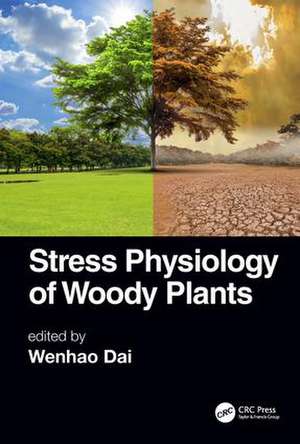Stress Physiology of Woody Plants
Editat de Wenhao Daien Limba Engleză Hardback – 9 mai 2019
Written by a group of experts, Stress Physiology of Woody Plants, is comprised of 11 chapters profoundly describing the uniqueness of plant structure, growth and development, photosynthesis and respiration, and growth regulation in woody species. It summarizes findings in the responses of woody plants to major environmental stresses including drought, nutrient deficiency, salinity, low temperature, oxidative stress, heavy metal, and multiple stresses.
Features:
- Provides a comprehensive review of physiological and molecular aspects of woody plants responding to some major environmental stresses.
- Bridges the gap between woody and herbaceous species in the field of general physiology and stress physiology.
- Describes the uniqueness of woody plants in plant structure, growth and development, photosynthesis and respiration, and growth regulation.
- Summarizes physiological and molecular responses to the environmental stresses in woody plants.
| Toate formatele și edițiile | Preț | Express |
|---|---|---|
| Paperback (1) | 439.08 lei 6-8 săpt. | |
| CRC Press – 30 iun 2021 | 439.08 lei 6-8 săpt. | |
| Hardback (1) | 1227.87 lei 6-8 săpt. | |
| CRC Press – 9 mai 2019 | 1227.87 lei 6-8 săpt. |
Preț: 1227.87 lei
Preț vechi: 1497.41 lei
-18% Nou
Puncte Express: 1842
Preț estimativ în valută:
234.98€ • 255.15$ • 197.38£
234.98€ • 255.15$ • 197.38£
Carte tipărită la comandă
Livrare economică 23 aprilie-07 mai
Preluare comenzi: 021 569.72.76
Specificații
ISBN-13: 9781498746083
ISBN-10: 149874608X
Pagini: 296
Ilustrații: 21 Line drawings, black and white; 16 Halftones, black and white; 10 Tables, black and white; 37 Illustrations, black and white
Dimensiuni: 178 x 254 x 18 mm
Greutate: 0.73 kg
Ediția:1
Editura: CRC Press
Colecția CRC Press
ISBN-10: 149874608X
Pagini: 296
Ilustrații: 21 Line drawings, black and white; 16 Halftones, black and white; 10 Tables, black and white; 37 Illustrations, black and white
Dimensiuni: 178 x 254 x 18 mm
Greutate: 0.73 kg
Ediția:1
Editura: CRC Press
Colecția CRC Press
Public țintă
Academic and Professional ReferenceCuprins
Introduction. Part I Plant growth and Development. Plant structure (uniqueness in woody plants). Plant Growth. Photosynthesis. Respiration. Plant Growth Regulation. Part II Plant Responses Under Stress Conditions. Plant Stresses. Plant response to water stress (drought and water logging). Plant Response to Nutrient Deficiency. Plant Response to Salinity Stress. Plant response to temperature stress (chilling, freezing, and heat). Plant Response to Oxidative Stress. Plant Response to Heavy Metal Stress. Plant Response to Multiple Stresses.
Notă biografică
Dr. Wenhao Dai received his PhD in plant science, specializing in woody plant physiology and biotechnology, from North Dakota State University in 2001. He was a Postdoctoral Research Associate in the AgBiotech Center at Rutgers University from 2001 – 2002. Currently, he is a Professor in the Department of Plant Sciences at North Dakota State University, leading the Woody Plant Physiology and Biotechnology program. Dr. Dai has more than 30 years of experience in woody plant research. His research areas cover woody plant physiology, biotechnology, molecular genetics, propagation, and production. Dr. Dai has taught several horticultural courses including Introductory Horticulture, Horticultural Science Laboratory, Plant Propagation, Fruit Crop Breeding, Fruit Crop Production, Nursery Production and Management, and Plant Tissue Culture and Biotechnology. Dr. Dai has published 39 research papers in peer-reviewed journals.
Recenzii
'Stress-induced problems suffered by trees and shrubs are of increasing concern as the world urbanizes at a rapid pace and people plant them in situations much different from the habitats in which they evolved. In this book, Dai (North Dakota State Univ.) offers a comprehensive review of the many physiological and molecular aspects of woody plant responses to major environmental stresses. The first four chapters review, respectively, our current understanding of woody plant structure; growth and development; photosynthesis and respiration; and growth regulation. Next come chapters on stress due to drought, nutrient deficiency, salinity, low temperature, oxidative stress, and heavy metals. A concluding chapter deals with plant responses to multiple stresses. Each chapter is concise yet readable, with its own detailed table of contents and extensive list of references to the primary literature. One quibble is that the infrequent black-and-white illustrations seem to be modeled on a textbook from the last century: they are functional at best. Given the book’s highly technical level, it is likely to find its readership among very advanced students and research professionals.'--G. D. Dreyer, emeritus, Connecticut College
Summing Up: Recommended. Upper-division undergraduates through faculty and professionals.
Choice Review, April 2020
Summing Up: Recommended. Upper-division undergraduates through faculty and professionals.
Choice Review, April 2020
Descriere
This book serves as a textbook and major reference by students and researchers of plant physiology, horticulture, forestry, and plant molecular biology and teaches a better understanding of the mechanisms of plant response to individual or combined stresses in woody species.
